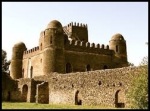
Throughout human history, every great empire has had great builders and phenomenal architectural fits: The Romans with Emperor Titus who built the Colosseum, the Inca builders of Machu Picchu, the Egyptian pharaohs with the great sphinx of Giza and the great pyramids, the first emperor of China and the Ming dynasty with the Great Wall of China. However, few today know of the Abyssinian builder Fasilides and his work.
Ethiopian Emperor Fasilides is one of most remarkable rulers of Abyssinia, the ancient name of Ethiopia. A member of the Solomonic dynasty, emperor Fasilides ruled over Abyssinia from 1632 to 1667. He founded the city of Gondar in 1636 which became the capital of Abyssinia, in the northwestern part of Ethiopia. He was known as Alam Sagad or ‘To whom the world bows.’ Today, thousands bow to his work, and his footprints have marked the history of Ethiopia forever.

Among the buildings he constructed there are the beginnings of the complex later known as Fasil Ghebbi, as well as some of the earliest of Gondar’s famous 44 churches: Adababay Iyasus, Adababay Tekle Haymanot, Atatami Mikael, Gimjabet Maryam, Fit Mikael, and Fit Abbo. Fasilides is also credited with building seven stone bridges in Ethiopia. Sebara Dildiy (broken bridge in Amharic) was one of two stone bridges built over the Blue Nile River during Fasilides reign. Sebara Dildiy was later repaired during Emperor Menelik II‘s reign in 1901. Emperor Fasilides also built the Cathedral Church of St Mary of Zion at Axum. Fasilides’ church is known today as the “Old Cathedral” and stands next to a newer cathedral built by Emperor Haile Selassie.

When King Fasilides made Gondar the seat of his empire in 1636, he constructed a palace that would eventually sprawl into a large complex, as succeessors added their own buildings to the compound. Set in the heart of what is now one of Ethiopia’s largest cities, the palace complex is a mixture of beautifully-preserved period architecture with European and Moorish influences, and rambling ruins. Interestingly, Fasilides’ Castle itself is the best-preserved, with its lower halls, reservoirs and steam-baths, remains of kitchens and stables, and even enclosures for leopards and lions that used to grace the grounds. The castle is located near the city center. Its structure is purely made of stone. Today, Fasilides baths are used for baptism during the Timkat festival, the epiphany, in late January; they are only filled with water for the festival. The castle can be found in Gondar, Amhara region. Fasilides’ Castle is definitely a representation of Ethiopia’s great and rich history.


the architecture I see in these images, I see them in shows about European history but it seems that Europeans are the ones who ripped off African architecture
LikeLike
this isnt “european influence” european castles have African influence idiot
LikeLike
Hello blogger, i must say you have high quality posts here.
Your page should go viral. You need initial traffic
boost only. How to get it? Search for: Mertiso’s tips go viral
LikeLike
Pingback: Gondar A History Tour | Free2Go